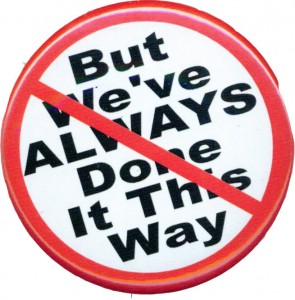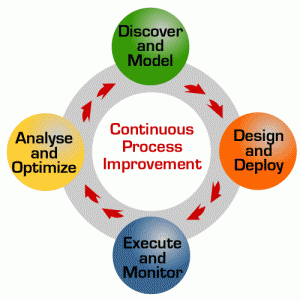Taking Control of the Phrase “Because We’ve Always Done it This Way”
The Pitfalls of “Step and Repeat” Process Control by Sandy Hubbard, Print Futurist
 “Focus over here in this corner and shoot here, and then move the copy over here and shoot this corner and go all around the edges of the copy. Then we will paste it together on the light table,” explained the earnest young man who was teaching me to use the camera at my first printing job.
“Focus over here in this corner and shoot here, and then move the copy over here and shoot this corner and go all around the edges of the copy. Then we will paste it together on the light table,” explained the earnest young man who was teaching me to use the camera at my first printing job.
I pointed to the knob on the side of the camera. “Ummm, doesn’t that adjust the distance of the copyboard? And that one adjusts the focus?” I asked.
“Oh,” he replied breezily. “The guy needs to come and tune up the camera. So we’re just doing a step and repeat for the time being. We used to shoot four pieces of film, so this way it actually saves some money.”
Doing as I was told, I shot the four exposures and carried the negative to my light table to begin assembling it back into one image.
The boss peered over my shoulder.
“What are you doing?” he asked.
When I told him, his face turned red.
It turns out that the shop had been doing step and repeat on that camera for two years (and shooting four pieces of film to assemble into one for a year before that ) despite the fact that the camera was now serviced on a regular basis. Needless to say, the boss immediately announced that we could use the camera the way it was intended, and he also reviewed our training procedures.
When you look around your business, whether you’re the owner or not, I bet you can find many processes that are done “because they’ve always been done that way.”
In the case of the camera example, a workaround had been developed that worked fine when time and money were no object — or when there were no new people entering the company. The goal in that case was to keep using the camera until it could be serviced, even if it meant using more materials, taking more time to shoot the copy, and using more resources to reassemble the image (often with not-so-great results).
What was a quick fix became institutionalized.

As an owner, inside manager or sales professional, get out on the floor and see how things are being done. Look at your waste streams. Talk to your employees. Examine your processes for places where these odd “step and repeat” curios have crept into production.
Process analysis is an ongoing job and should happen at all levels within your organization. Opening up staff time previously dedicated to time wasters can mean the ability to add new services or get a job out the door quicker. And finding even a modest savings in time and materials can make the difference in competing successfully your next bid.
Sandy Hubbard is Print Futurist at PrintMediaCentr. She spent 22 years publishing a monthly trade magazine for the printing industry and grew up in a multi-generation family of printers.











